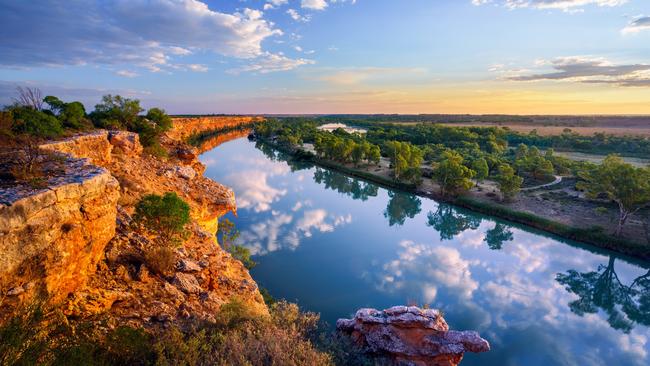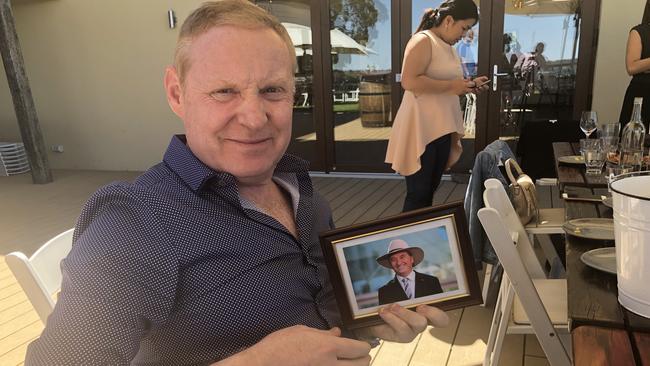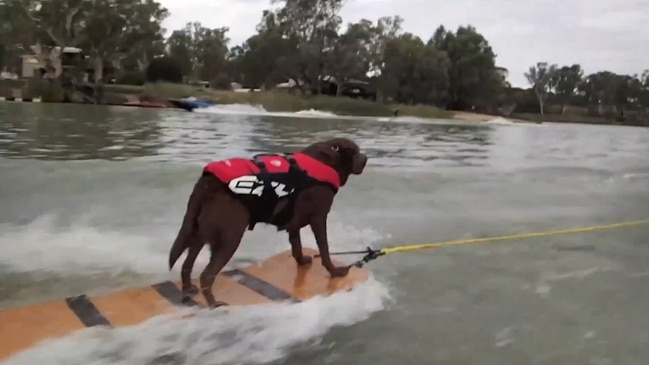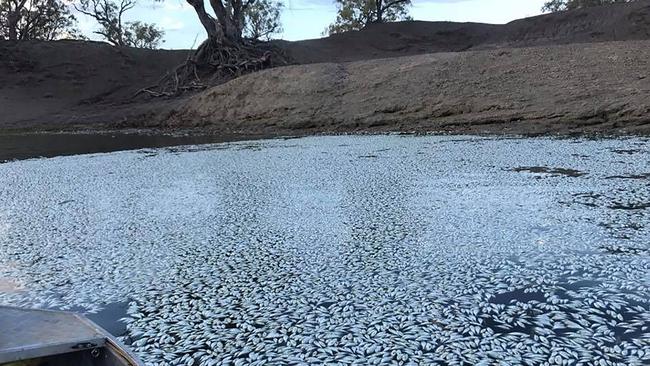SA Weekend: Top silk Richard Beasley says water basin is in crisis and SA has been dudded
A former Adelaide lawyer, now top Sydney silk, is fired up about the “unlawful drafting” of the Murray Darling Basin plan, which he says, has ‘f..ked over’ SA. He’s so angry, he says he’d have Barnaby Joyce’s testicles on a plate, if he could.
SA Weekend
Don't miss out on the headlines from SA Weekend. Followed categories will be added to My News.
Richard Beasley, SC, enjoys stirring the pot. When the legal website Justinian asked the prominent barrister what he’d like for his last meal – should he ever find himself a condemned man – he replied: “Barnaby Joyce’s testicles.”
Beasley, who started his legal career in Adelaide before moving to Sydney, is a Senior Counsel with a national profile. And, he offers reassuringly, not at all cannibalistic.
“If I was going to have my last meal, Barnaby Joyce’s testicles would almost literally be the last thing I would have,” he says.
But if Joyce is off the plate, the former National Party leader and federal water minister is very much on the nose with Beasley.
He is fired up about what he calls the “unlawful drafting” of the Murray Darling Basin Plan, and the “appalling mismanagement” of that plan by politicians and bureaucrats.
The federal National Party is in his sights.
“I think it’s a conflict of interest for the National Party to be given the water portfolio,” he says, arguing it is biased to farmers over the environment.
“It’s not in the Australian national interest.”
But the Nationals are just part of a long list of what makes Beasley angry about the management of the basin.
So angry that he has written a book, due early next year, he hopes will convince ordinary Australians that a crisis is engulfing the river system because of over-extraction of water.

It’s a catastrophe that is degrading the Basin’s wetlands and will kill the River Murray from the mouth up, and ought to anger everyone in SA, he says.
Claims that the current levels of water going to the environment are sufficient or scientific are “a lie”.
The Murray-Darling Basin Plan of 2012 was supposed to save this vital national asset. But Beasley says its implementation by the federal Coalition since 2013 has been “an absolute disgrace” – although he says it has been unlawful from the time it was legislated in late 2012.
Also, he contends, the Marshall Government has done nothing to convince Canberra to change tack. “Pathetic,” he says of SA’s efforts.
“South Australia is getting f..ked over by this illegality, f..ked over by water theft, f..ked over by flood plain harvesting, and f..ked over by the eastern states and Queensland.”
Beasley’s fury stems from what he learned in 2018 as Senior Counsel assisting the Royal Commission into the Murray-Darling Basin called by former Premier Jay Weatherill before Labor lost office.
Now he faces the challenge of translating such a mind-numbingly complex topic into a riveting story. But he’s not short on material, thanks to some larger-than-life characters, stormy public rows, accusations of theft, claims of bullying and backstabbing, threats of reprisals, and secret decision-making.

Also, the 56-year-old knows how to spin a yarn, having written five novels with a sixth on the way. His first also had a watery link – Hell has Harbour Views, a biting satire on big-charging Sydney law firms that was made into a successful ABC TV drama.
The new one, Dead in the Water, will be published early next year by Allen & Unwin, he says from his Sydney chambers, fresh from his role as Senior Counsel at the Ruby Princess inquiry.
That inquiry, ordered by the NSW Liberal Government, found that state’s health department bungled the arrival of the cruise ship, allowing the spread of COVID-19 across the country, causing at least 28 deaths. In that inquiry, Beasley assisted Sydney lawyer Bret Walker, SC, who also acted as Royal Commissioner in the Murray inquiry. They are a regular team, and Beasley says Walker is “the smartest person I’ve ever met”.
In his January 2019 report, Walker called for a rewrite of the Basin Plan. He said it was unlawful because the amount of water it allots to the environment is not calculated according to “the best available scientific knowledge” as required by the Water Act. Instead, his report said it has been driven by politics.
Walker also found, to the anger of SA’s premier Steven Marshall, that a policy switch by his environment minister David Speirs had likely denied SA a vast amount of vital water.
Speirs, the commissioner said, had acted so much against SA’s interests that he’d broken the ministerial code of conduct. That was rejected by Marshall and Speirs.

The Murray-Darling Basin Authority also denied the findings it acted unlawfully and hadn’t heeding the best scientific advice.
Beasley is unmoved. He says he and Walker were outraged by the unlawfulness, maladministration, gross negligence, and incomprehensible decision-making the Commission found. But while Walker has confined his views to the report, Beasley has decided he won’t be silent.
“As counsel assisting, I said to him if this just gets ignored – which we knew it would – I’m not going to shut up about it.”
Beasley is not your stereotypical lawyer. He doesn’t hide his political views, which tend to the Left, and says he’s a friend of Weatherill. But, he adds, a lawyer must put aside prejudices and personal beliefs once they’re engaged in a case, and nothing he is saying on the Murray-Darling Basin is influenced by his politics.
But he does plead guilty to being a stirrer. “I do, because people need to be stirred.”
Clearly, that angers some. But long-time Sydney journalist and editor Richard Ackland, who publishes online legal magazine Justinian, says Beasley is “a breath of fresh air” at the bar.
“He’s naughty, irreverent and very clever,” he says, unlike most of the “stuffy, up-themselves” legal types who’d never say anything remotely controversial.
It was in reply to questions from Ackland for an “on the couch” article that Beasley mentioned Joyce’s bits. In a similar vein he said his favourite movie was Some Like it Hot. “It’s the first film that dealt with cross-dressing, sexism and the LNP’s attitude to climate change.”
Beasley agrees he’s irreverent and describes his humour as “fairly well-informed and reasonably sharp”. He also has a regular repartee on Twitter with one of his fictional characters, a barrister named Peter Tanner who once queried: “Richard – could you really eat BOTH of Barnaby Joyce’s testicles?”
“Somehow he manages to get himself on Twitter,” Beasley says. “I’m not sure how a fictitious person does that, but he manages it. And he asserts that he’s some kind of friend of mine so I just go along with that. You can’t have too many friends.”
Perhaps his independent streak isn’t surprising, given his mother, Mary Beasley, was a South Australian trailblazer, appointed by Premier Don Dunstan in 1976 as the nation’s first equal opportunity commissioner.
At 19, she’d married John Beasley in Sydney but the relationship didn’t last so she returned to Adelaide with baby Richard, who has no memory of his father.
“I never met him,” Beasley says. “My parents had no contact with each other and my father died in a car accident when I was about 20 and I’d still never met him.”
His preschool years were spent at the Kensington Hotel, which his grandparents ran, while Mary worked at a job placement agency. He attended “that well-known Bolshevik organisation” St Peter’s College, but his early influences were definitely not conservative.

“Most of my mum’s friends she had around to dinner were pretty strong feminists, so I certainly have strong recollections at a young age of being exposed to fairly Left-wing feminist views,” he recalls. “I certainly wouldn’t describe myself as either neoliberal or Right wing.”
Beasley left school at 17 and studied medicine. He didn’t like it, so switched to law. Medicine was a mistake, he says. “Who knows,” he adds, “law might have been a mistake, too.”
He had no great desire to be a lawyer, but “I got the degree and I started working and I still am”. His start was at a Labor-linked firm Duncan Groom & Hannon where he recalls colleagues like Weatherill, a friend with whom he shared a house, and Labor federal frontbencher Mark Butler. “I don’t think too many people who follow the Nats or the Libs ever went through as an employee of that firm, but I could be wrong,” he laughs.
By his mid-twenties, Beasley had packed and gone to Sydney to work as a solicitor. He wondered some days what he was doing with his life. It turned out that he was gathering material for his first book. And when he jumped from his legal firm to try his luck as a barrister in a town where he knew relatively few people, he found he had plenty of spare time to write it.
The plan was for a more literary version of a John Grisham legal thriller. But his story – of a handsome young lawyer who fancies himself as a real-life Atticus Finch but sells his soul for an office with harbour views – turned out to be a biting satire of big-charging law firms.
Author John Birmingham called it “the funniest, most unutterably savage lawyer joke ever” but others, recalls Beasley, said it was “the longest suicide note for a career at the NSW bar ever written”.

Still, when to his surprise someone published it, he got a folder full of letters from grateful young lawyers who wrote he’d just described their life. Then the ABC made a TV drama. Better still, nobody sued him – and he only got one complaint to his face.
“I was standing at the traffic lights, and the next thing I’ve got this bloke behind me saying: ‘How could you have written that f..king ridiculous book?’ I turned around and said, ‘Oh hello, how are you?’ ‘F..king defamation!’ I went, ‘Oh, really?’ And the conversation deteriorated from there.”
For a Lefty lawyer, who like his main character was confused about his life, it was a chance to vent. “I think it was me cleansing my soul for having spent a few years of my career in commercial litigation – which I would call glorified debt collecting or kicking people out of their houses. So yeah, it was a soul cleansing exercise in relation to big charging lawyers not necessarily behaving in what could be loosely termed the best traditions of the legal profession.”
Maybe his first nonfiction is more of that. He’s still a big charging lawyer – his bill for the SA government for his royal commission work was reportedly around $800,000 – but rather than just moving on from that inquiry he’s chosen to fight on in print.
One reason bureaucrats and politicians had been able to get away with the “maladministration, negligence and incomprehensible decision-making” Bret Walker found is because few people understand what’s been going on, he thinks. The book, he hopes, can help change that.
“It’s in my blood now,” he says of the Murray.
Making water policy a racy read will be a challenge, but there’s no argument it’s important. The basin covers a vast slab of SA, Victoria, NSW and Queensland, hosts 2.6 million people, 23 rivers, 40 Aboriginal nations, and produces $24 billion worth of food and fibre – everything from wine to cotton, rice, citrus and vegetables – much of it from more than 9000 irrigated properties.
Despite growing up in SA, Beasley admits he was no expert on the Murray, the final leg of a system that starts 3400km away in Queensland, before Weatherill ordered a Royal Commission into the state of the Murray-Darling Basin plan.
“Obviously I knew about the Coorong and I knew sites in SA but water law, water politics, the governance of the Murray-Darling Basin – every issue about it, including the scientific issues, are incredibly complicated,” Beasley says.
The idea of the basin plan drawn up in 2012 was not that agriculture should stop, he stresses.
“It’s based on the realisation that we’ve over-allocated how much water can be used for agriculture, food and fibre, and we need to do something about it because it’s causing massive degradation to the environment,” he says.
To do that, the federal Water Act legally requires an amount of water be set aside for the environment “based on ‘the best available scientific knowledge’ and nothing else”.
“What happened was the basin authority did it that way, and the politicians decided that figure was too high,” Beasley says.

The royal commission took evidence that scientists recommended 4000-7000 GL (billion litres) a year be returned to the environment, but the basin authority insisted the figure had to start with a two. “It became a postcode joke – a NSW postcode was the figure.”
Then, when the CSIRO was asked to report on the environmental benefits of returning 2800GL to the environment, the scientists replied in essence “that wouldn’t achieve very much”, Beasley says. “And the basin authority said, we don’t like that report. And a very senior person writing the key chapter at the CSIRO was pressured to alter the report that he described in sworn evidence – he’s now a senior person at the ANU – as ‘scientific censorship’ and misleading.
“The atmosphere was so bad at the CSIRO that management, again this is his sworn evidence, had to bring in a mediator or facilitator to deal with staff unrest at what I’d call the scientific doctoring of that report by the basin authority.”
The witness revealed that pressure to change the report extended to a threat that the CSIRO’s fee may not be paid, he says. “I just found that outrageous,” Beasley says. “I still view that as something that requires – it doesn’t matter that this happened seven years ago – a full investigation.”
The CSIRO disagrees. It has denied it was pressured to change its report in an improper and misleading way by the basin authority. “We strongly reject suggestions that CSIRO’s scientific integrity was compromised, its independence undermined, or that it acted in secrecy,” it says.

Beasley says in the end the number decided on was 2750GL. SA didn’t agree, but signed up on the basis it would rise to 3200GL. “SA would get this extra 450GL of water through various ‘efficiency schemes’ that meant farmers in the other states would use water more efficiently,” he says. (For context, 450GL is only 50GL short of the volume of water in Sydney Harbour).
That water is now due by 2024. It will never happen, Beasley says. “There was a meeting of the state and federal water ministers at Rigoni’s restaurant in Adelaide in late 2016 where (SA’s) Ian Hunter told Barnaby Joyce to go and get f..ked …because Barnaby had written ... to Mr Hunter basically telling him ‘you are not going to get the 450’.”
The Marshall Government took a less confrontational approach after its March 2018 election. And in December 2018, just as the Royal Commission had finished its report, SA environment minister David Speirs adopted a new policy to getting the 450GL.
Beasley says Speirs agreed that if any of the efficiency measures crucial to getting the extra water put even one job at risk in NSW or Victoria, they would not need to proceed. “It basically was the death knell of getting that 450GL of water,” Beasley says, adding that this new socio-economic criterion was contrary to what Speirs had told the commission.
“So the Commissioner got the report back from the printer and made a fairly scathing finding about David Speirs, saying he’d acted contrary to the interests of South Australia and should reverse this.”

Marshall hit out at Walker’s criticism, calling it “ludicrous and nonsensical”, while Speirs said he’d been denied procedural fairness. He rejects Beasley’s assertions, telling SAWeekend the lawyer is no water expert, and castigating the royal commission report as a $5m waste of money. Its staff list resembled an ALP sub-branch, he claimed.
In fact, says Speirs, progress has already been made to getting 150GL of the 450GL with new projects identified and soon to begin. And, if these and other projects don’t deliver that promised 450GL for the environment?
The federal government will have to buy the water from irrigators, he says. That is a legally enforceable requirement. Infrastructure projects that made farms more efficient and use less water would be the best option, and also deliver jobs to remote river areas – but if that does not happen, buybacks will be required.
One way or another, Speirs insists it’s a legal deal that must be met by 2024 when the plan is reviewed.
Beasley says it won’t happen. “No-one should hold their breath.” Beasley says the likelihood of the extra water coming to SA has become even less.
The plan to find 2750GL (roughly 20 per cent of what irrigators had been allotted) for the environment has become now 2075GL. New infrastructure projects on the rivers, or new ways of operating the river – called “Supply Measures” under the basin plan – are supposed to make up for 605GL of that.
The theory is these new projects – things like regulators on the river, or new ways of draining lakes like the Menindee Lakes – will get “equivalent environmental outcomes” from 605GL of water less per year.

Beasley describes these Supply Measures as closer to pseudoscience than real science. In the Northern Basin, 70GL of water due to be returned to the environment each year was taken out as a result of a controversial amendment to the basin plan in early 2018. “So I’m angry about that, because that has absolutely no scientific validity at all,” Beasley says.
Beasley has a radical fix for the problem. “My solution at the moment, because I’m so disgusted by the way things are done, is that ownership of all the water in the Murray-Darling Basin system should be given to the Aboriginal nations,” he says. “Native title – for the first time – over water, not just land. Every drop.”
The alternative, he says, is for the Water Act to be rewritten so that it no longer puts the needs to the environment first.
“The thing that upsets me most is, if a lawful figure of water to go back to the environment is too much for rural Australia to bear, fine – but change the Act,” he says. “What’s happened now is you’ve got politics dressed up as science.”
A comprehensive update to the plan that includes the impact of climate change is vital. And then a decision might well be made that some parts of the environment might need to be sacrificed. “But at least be honest.”
He remains scathing of the Marshall Government. Its response to the 764-page report was a 26-page pamphlet, half of which was photographs, he says. “It was a risible response to a detailed royal commission report of vital interest to every South Australian … frankly contemptible.”
SA is not changing its stand under the current government, though. Speirs says those are the exact words he would use to describe the royal commission’s report.
Beasley says the state will pay a price for that attitude.
“The long-term consequences will be less water flowing down past the Victorian border and the ongoing degradation of the Coorong – the most iconic and important wetland in the country,” he says.
“And the Murray will gradually die from the mouth up … from a combination of climate change and mismanagement of the Murray-Darling Basin.”
